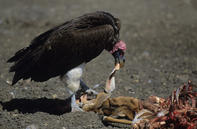
Lappet-faced Vulture
Name
Lappet-faced vulture (Torgos tracheliotos)
Also referred to as a Nubian vulture
Appearance
This is the largest and most dominant of the vultures in South Africa. Apart from its large size, around 105 cm tall and weighing around 7 kgs, it is dark brown or black in colour, with white thighs. It has a bald red to pink head and lappets (skin folds).
A huge yellowish meat-hook bill also stands out on this vulture. This is the only truly bald vulture. The lappet-faced vulture displays a white bar on the underwing when in flight. It has a wingspan of 2.8 m.
Lappet-faced Vulture Diet
Feeds on carcasses. The lappet-faced vulture will tackle parts of the carcass that is too tough for other breeds of vultures, like the skin, tendons and ligaments.
Lappet-faced Vulture Breeding
The lappet-faced vulture breed between May and February, during the dry season in northern South Africa. They lay a single egg and both parents incubate the egg for around 55 days.
The fledgelings are dependent on the adults for around 6 months.
Lappet-faced Vulture Behaviour
The lappet-faced vulture is a sociable vulture and will interact with other scavengers at a carcass.
Threats
The lappet-faced vulture is listed as endangered from 2015.
One of the lappet-faced vulture’s biggest threats is poisoning. Poachers of large mammals lace the carcass with poison to try and hide the carcass. The vultures then feed on the carcass and die. They are also hunted for their body parts, for use in traditional medicine.
Distribution and Habitat
This vulture is found in the far north of South Africa. The lappet-faced vulture favours semi-arid open woodland.
